TL;DR
- The AI + Content Bubble May Pop Soon?
- AI + Automation Taking Over Time Consuming Tasks
- SaaS Influencer Marketing On The Rise
- Direct Marketing and In-Person Trade Shows/Events Remain the Top Areas Where SaaS Marketers Are Putting Their Budget
- Employees Building More Personal Brands and Becoming Brand Advocates
- More Content Diversification Beyond Just Blog Articles
- TikTok May Still Be An Untapped Market
- Cold Email Becoming a More Profitable and Effective Marketing Channel
- Video Marketing Will Continue to Grow as a Main Content Type
- SaaS Marketers Will Prioritize Brand Awareness Over Lead Generation
- Webinars Will Continue to Be Effective for Brand Awareness and Lead Generation
With 2023 in the past, it’s been quite a tumultuous year. From AI rollouts to frequent Google Algorithm Updates, we’ve seen a lot of volatility in the marketing and SEO space.
With everything going on, it can be easy to get lost in the noise of changes.
While a lot of it is just “noise,” we’ll want to consider a few trends lurking in the distance that can change what marketers day to day look like.
While most of these trends won’t disrupt marketing/SEO or cause any significant changes, it’s still worth understanding what these trends are and how they can affect us.
That’s why I asked some well-known marketers in the SaaS space what their thoughts were on the biggest marketing trends for 2024.
From artificial intelligence to video content, here are a few B2B SaaS marketing trends to know for 2024.
SaaS Marketing Trends to Watch Out For
1. The AI + Content Bubble May Pop Soon?
Obviously, AI will be the trend at the top of this list.
It’s been practically unavoidable for the last few years. Whether you’re creating pictures with Midjourney or DALL-E, prompting with ChatGPT or Claude, or even using it for content creation, you probably haven’t been able to escape it.
While AI may still be in its infancy, there’s no doubt it will be a disrupter for many marketing teams, not just in the SaaS space.
Whether that change is good or bad is still to be seen.
But a few marketing experts shared their thoughts on where AI and content marketing is headed and what changes we can expect to see.
Sara Stella Lattanzio, Adnovum’s senior marketing manager, said, “I don’t think this whole AI bubble will be a nothing burger, but the bubble will pop at some point, and I’m wondering what will happen when every site has the same AI-generated blog posts and plastic Midjourney images.”
It’s definitely a point to consider, especially when a recent Verge article criticized the SEO industry for littering the internet with spam.
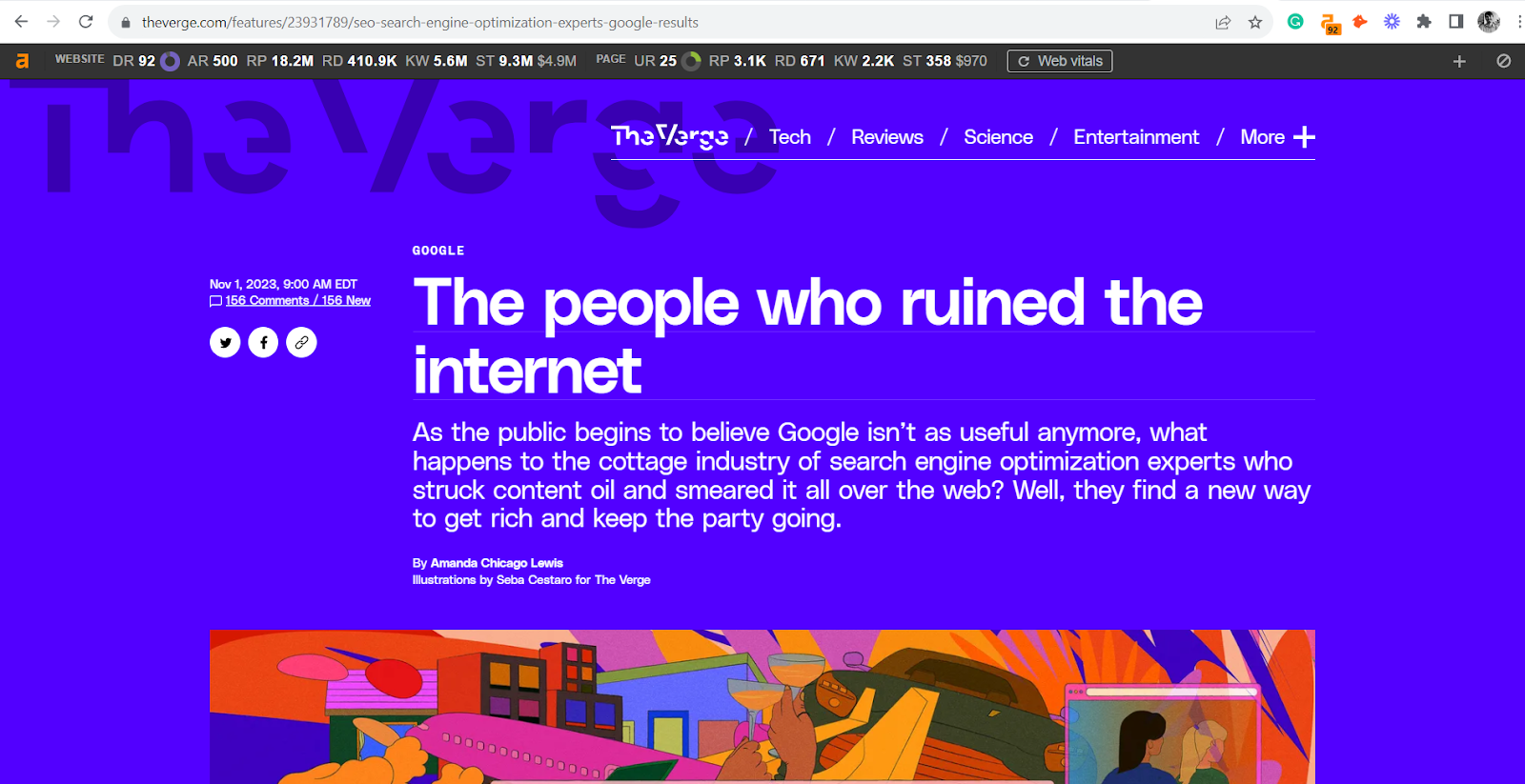
AI hasn’t even begun to peak with content creation, so I can imagine this will only get worse before it gets better (which may mean another Verge article on the horizon).

In fact, Jake Ward, the cofounder of Byword and content marketing agency Content Growth, created a tweet detailing how he pulled off a bold SEO heist using only AI.
What was meant to be a case study on his SEO AI tool turned into quite a controversial post.
Inflamed by tensions brought on by the recent Verge article, SEOs across the entire industry were denouncing his efforts.
His singular case study was even picked up by well-known publications like Politico and PC Gamer.
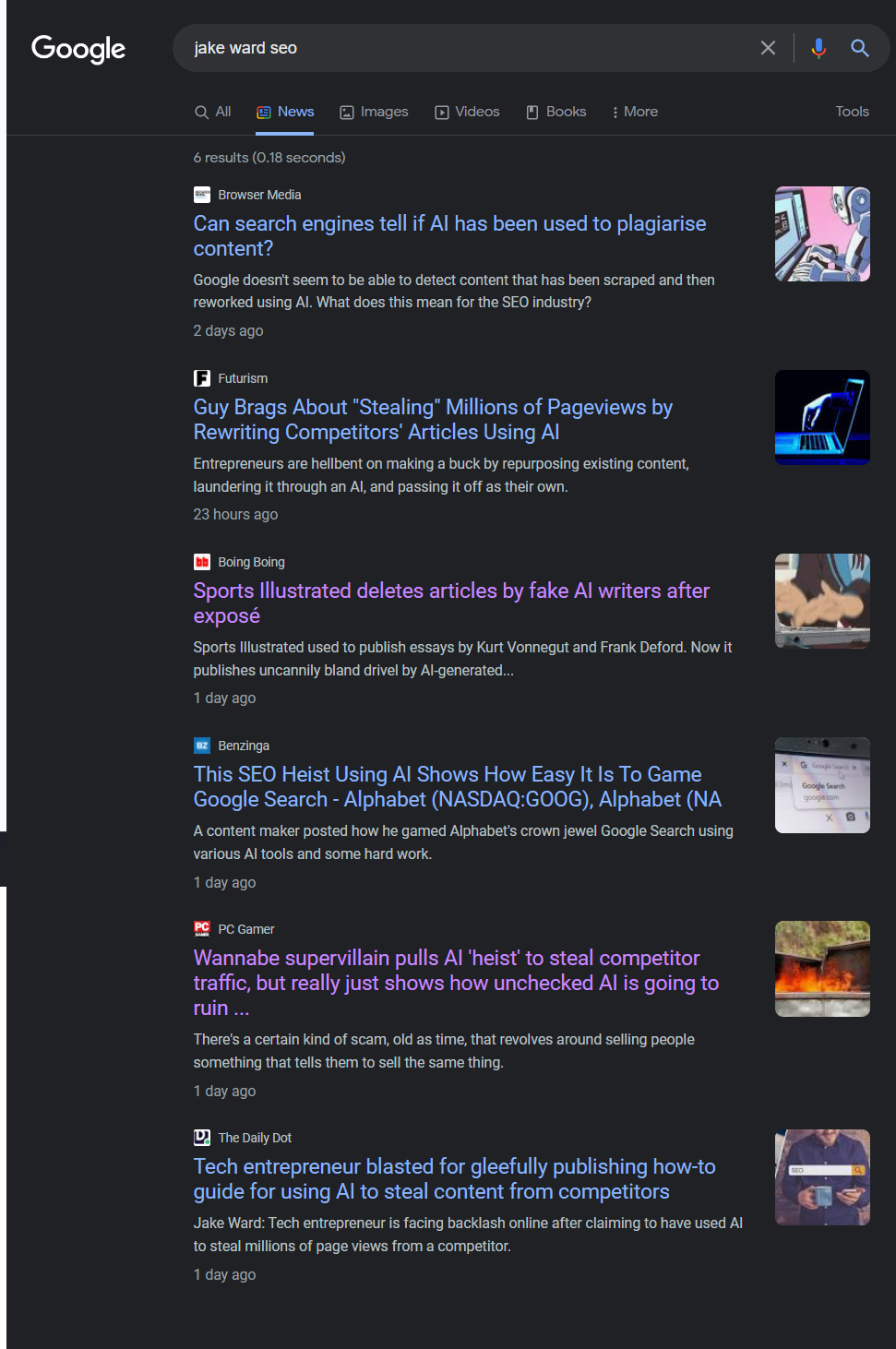
He even received multiple violent threats, all because of one social post.
So it is safe to say that AI is a contentious topic for many marketing teams, not even just SaaS, especially when it can be easily manipulated like this.

While there’s nothing inherently wrong with using AI content – especially if you’re using it to create actual helpful content – there is an issue when you create 2,000 pages with a click of a button without any human review.
Especially when AI is just reusing existing information based on machine learning algorithms, meaning it’s not adding new to the conversation. Now, I will say you can prompt ChatGPT and Claude to create genuinely good content, but it all comes down to the person prompting the LLM.
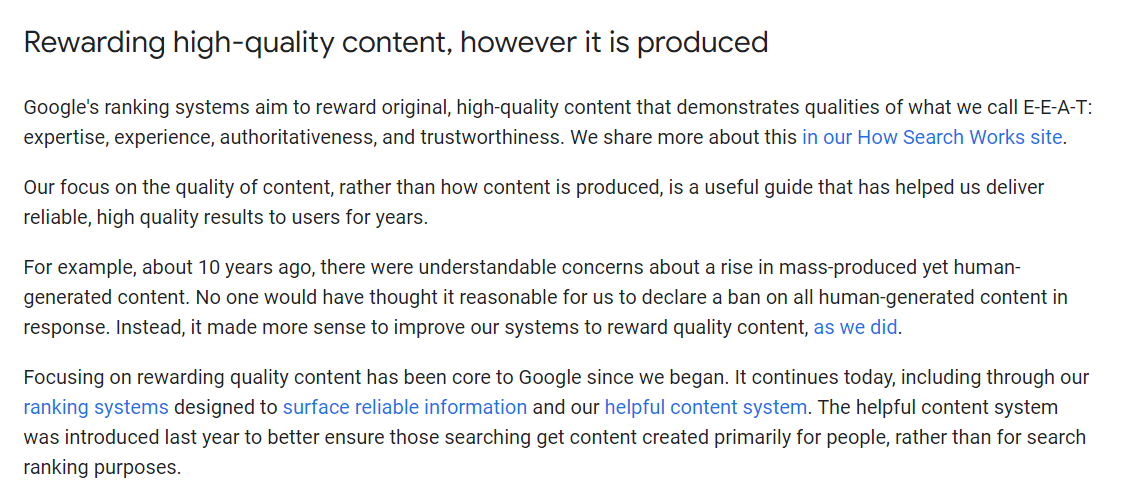
Most of these AI case studies also fail to mention the long-term growth of these websites.
In fact, there have been multiple instances where people have identified the original websites used for these case studies, only to find out that they’ve completely fallen off a cliff in terms of traffic.

In this case, it looks like Google actually issued a manual penalty for content spamming.
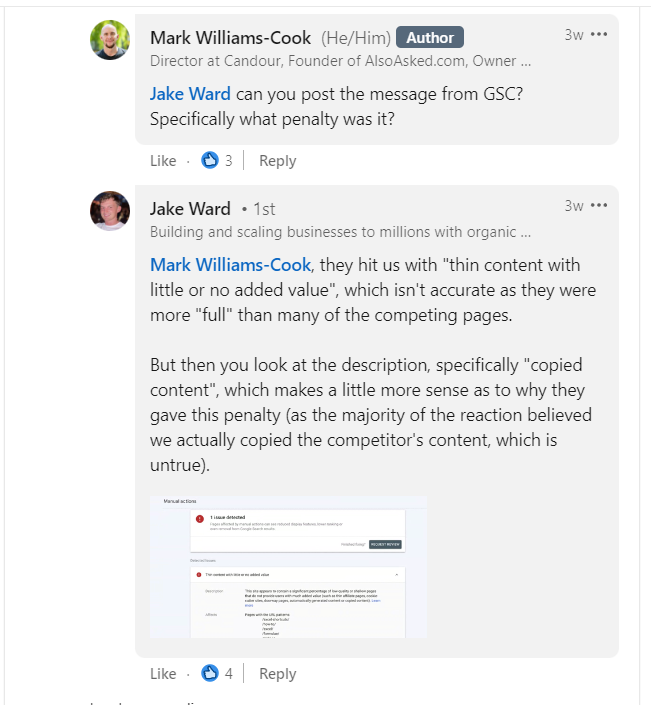

So, while AI has its benefits with content creation, you only want to use it to create genuinely helpful content that adds additional value, not just rewording. In this case, no human editing was involved; they were just using AI to pump out articles at scale. If there was more human involvement, the penalty likely wouldn’t have been issued.
*As a disclaimer, while I don’t agree with what Jake did, the backlash he received was entirely unwarranted. People attacking him and making death threats???. Like come on, he is human after all, and I can vouch that he seems like a decent person from the times I’ve talked to him*
But not everything has to be a growth sprint either; slow and sustainable growth is fine, especially for most SEO strategies.
Akarsh Kavuttan, an SEO manager at Botpresso, said, “I believe content speaks for itself, but how you integrate/leverage AI to solve real-life user problems can be a game changer!”
So even in some cases, you can use AI to improve your content and make it more interactive for your readers.
You can even leverage AI to create elements for your content, like tables or graphs. In some cases, I’ve seen websites create custom scripts to include in their content.
Lel Barry, a content writer for the Alibaba Group, had this to say about SaaS content marketing using AI: I anticipate a steady growth in the use of AI + Content Marketing. SaaS brands will look at scaling their content production using AI. However, they’ll be forced to hire more writers to humanize the content and be less robotic.
Now, this is the direction I believe AI will be headed with content.
AI will be integrated into most marketing campaigns, but human involvement will still be needed to proof the final result.
Writers will create the initial outline, prompt the large language model, and edit the final output.
As you can see, AI isn’t always a negative for content. In some cases, you can even use it to upgrade your content.
Another thought to consider is one by James De Roche, founder of Lead Comet: I see AI and the flood of content making competition fiercer than ever. But I don’t think that “More is better”. In fact, I think that more businesses will dial back efforts and focus on a few strategic channels as the difficulty of managing an omnichannel approach at scale becomes quickly apparent. Customer research, data, and storytelling will be the primary drivers of success with content marketing. And there will be less tolerance for noise. Attention will be at a premium. You’ll have fewer opportunities to resonate, so content must be more helpful and thorough than ever. Potential customers will look for products and services that are more niche to their needs as a way to sort through the noise. Doing everything for everyone won’t be an effective business strategy moving forward. Marketing and sales alignment trends will continue. And due to budget constraints, there will be more of an emphasis on creating assets that can also function as sales enablement content. That’s one way to “get more with less.”
So if anything, we may see an adverse effect of users seeking out helpful content to get around all of the AI spam out there. It’s almost like we may see users searching for content that they can trust, which can ultimately turn into brand trust.
And Ben Goodey, founder of How The F*ck, had this interesting point to say: I think generative AI will help redefine what “quality” means. When everyone has access to OK writing, brands will polarise toward quality or quantity. It’s now harder to say, “We don’t have the budget for content” when it’s so easy to produce so that more companies will test quantity content…and when that doesn’t drive growth, that will awaken more and more people to the value of great writers who can sell SaaS products authentically in content. Generative AI also gives marketers something to rally against and win budget for doubling down on people-first, high-end content.
While AI has plenty of uncertainties, it’s at least here to stay. But how you use it will make all the difference.
By the way, make sure to follow all of these people on LinkedIn. Their content is always top-notch.
2. AI + Automation Taking Over Time Consuming Tasks
Continuing the trend of AI, another trend we can expect to see is more effective automation brought on by AI.
Jacob Statler, the founder of StatDigital, said this about AI and automation: Nobody wants to hear it, but I’ll state the obvious. Decreasing headcounts in favor of AI software solutions that can replace grunt work. High-level-thinking marketers will be the last ones standing. I think this will help us focus more on the fundamentals that work instead of getting into the weeds of how to do stuff.
Obviously, Jacob’s point has many different levels to it, but this is likely the route AI will take us.
Automation of tasks that were otherwise delegated by higher-level employees.
It’s not that automation will cancel out marketing positions altogether, but it certainly will affect marketers day-to-day and free up their time from tedious manual work.
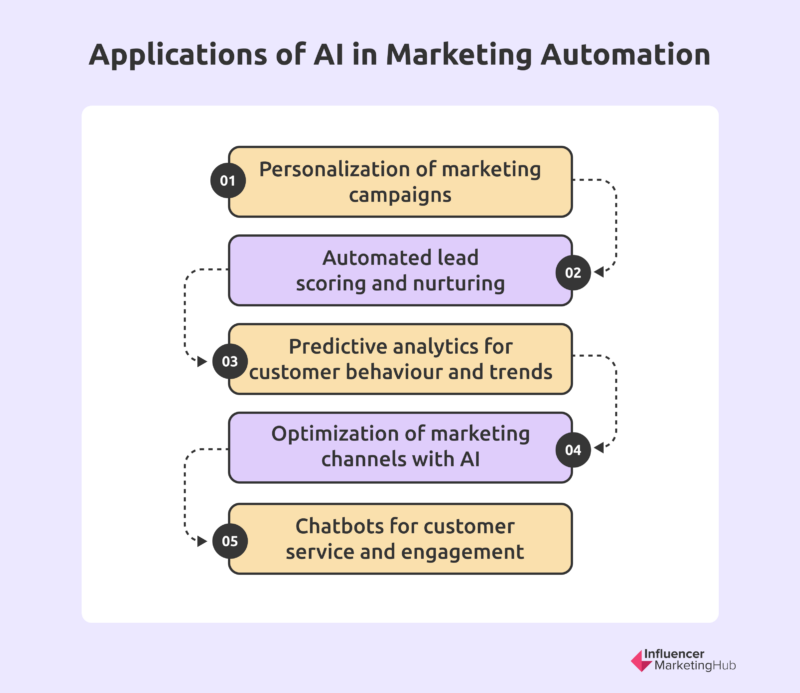
Source: InfluencerMarketingHub
I asked Jacob if he thought this was a net negative or net positive for the industry, and his response was: Net negative for the average employee. Net positive for industry leaders. Although that doesn’t really matter. Change is inevitable, and it’s time to adapt.
And I agree that this will mainly “benefit” the company’s bottom line and not the average employee; however, it’s worth mentioning that automation will still require human input to check the final output.
Because of that, I still believe automation won’t cause many job losses (emphasis on many because you never know). But AI + automation should lead to more lever-pulling than actual manual work.

If it can make marketers more productive than great, but as we’ve seen with AI, people become too trusting of it and think they can put all their faith into it.
As I mentioned before, AI is still very much in its infancy phases, so all of this is pure speculation as to where it can end up.
As long as there aren’t any companies named Skynet, then we should be fine.

3. B2B Influencer Marketing On The Rise
Influencer marketing is one I think most marketers neglect, especially when it comes to B2B marketing.
We’ve seen influencer marketing work exceptionally well for B2C companies, and we’re now starting to see growth for B2B.
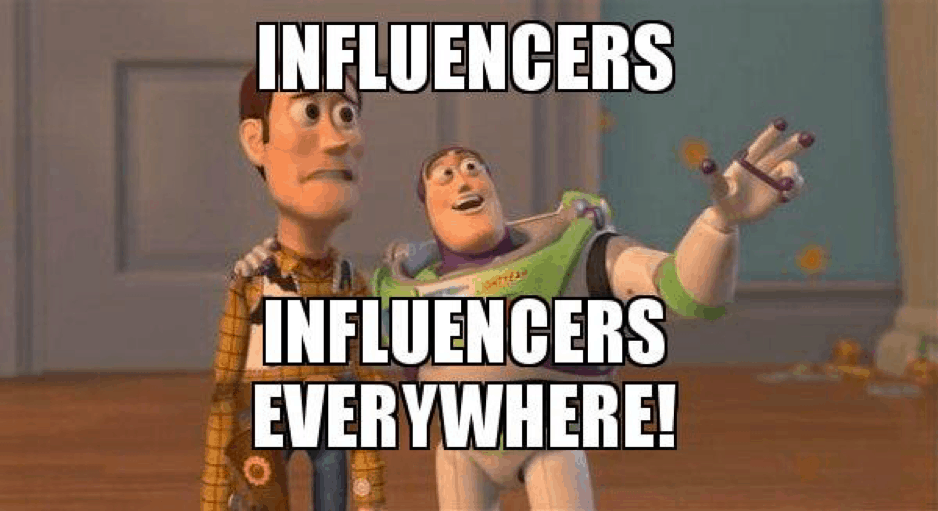
It makes total sense for B2B SaaS marketing strategies too.
With how many touchpoints are involved in your audience’s buyers’ journey (and marketing/sales funnel), you should focus on marketing channels that aren’t time or resource-intensive.
With influencer marketing, you can essentially outsource brand building to industry leaders (come on, industry leaders are influencing with a fancier title – they are “influencing,” after all) to existing or new audiences.
When we market ourselves, we’re often just boasting about our brand/products and attempting to convince our buyers that we’re the right solution for them.

But the problem comes from the fact that our target audience likely won’t just trust us at our word.
Case studies and testimonials help, but your target audience will do more research beyond just your website, especially in B2B.
For B2B SaaS companies with long sales cycles, you can expect users to spend hours researching your brand before making a purchasing decision.
They want to ultimately see if your product is the right solution for them.
This means researching things like:
- Customer reviews and Testimonials (social proof)
- Social Media and Forums
- Media References and Press Releases
- Case Studies and Success Stories
So a lot of influencer marketing comes down to building trust with these new or existing audiences.
Someone typically well-regarded or trusted in an industry can help build trust for your product by creating content around it.
And where most fail is just by promoting the product and trying to traditionally “sell” it.
This applies to your content marketing efforts too, but if you want to build interest and trust for your brand, your influencers have to show their audience why they should be using the tool. Meaning, how they’re using your solution to make their marketing more effective. They are considered to be industry leaders for a reason.
Industry leaders are trusted because they’ve run well-known campaigns or proven knowledgeable/successful in their field.
People follow them because they want to learn what they know. They want to improve themselves based on the skills these industry leaders have. It’s almost a bit of FOMO. They want to be where they are, but they just aren’t there yet. Marketing is way more psychological than you may think.
That’s why when they take a product-led approach and show off your product (show, not tell), they’re showing impressionable audiences how the product works and how it makes their lives easier, and thus, how it can make your audience’s lives easier too.
B2B influencer marketing is all about messaging and trust.
4. Direct Marketing and In-Person Trade Shows/Events Remain the Top Areas Where Marketers Are Putting Their Budget
In Sagefrog’s marketing mix report, they found that in-person events were B2B marketers’ top areas of spend in 2023 and going into 2024.
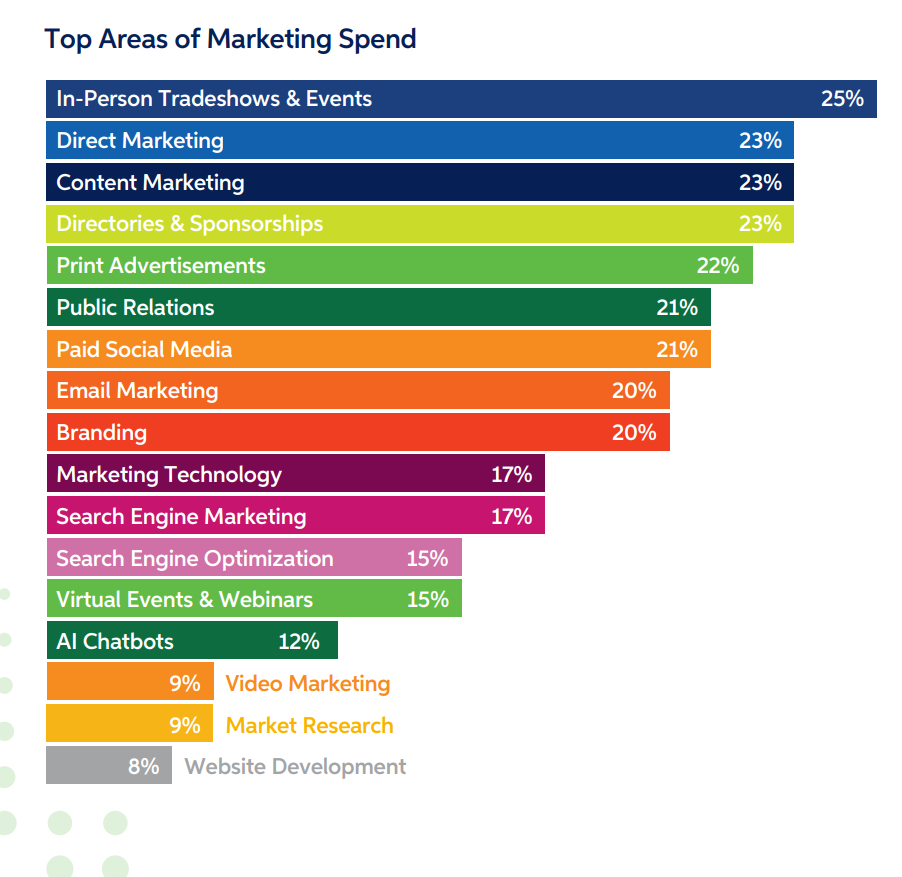
While this may seem like a shocker, it actually makes more sense than you might think. We’re almost entirely back to pre-pandemic levels, and marketers (specifically more traditional marketers) want to revert back to the good ole days.

Marketers are becoming more comfortable returning to in-person events rather than sticking with the digital-heavy era we saw during the pandemic.
What’s also worth mentioning is the growing interest in direct marketing.
Meaning direct mail marketing.
It seems like we’ve almost gone full circle from cold email. Direct mail was spammed to no end, where email was initially seen as a more protected space.
Email now has become almost a constant source of noise, with the average worker receiving up to 121 emails every workday.
With direct marketing, you can cut directly through the noise and nurture your audience without competing with 100s of other notifications. It also helps that mail is a tangible object, whereas email is strictly digital.
That’s not bash email either; email marketing still has one of the lowest customer acquisition costs ($510 average) across all marketing channels (inbound and outbound).
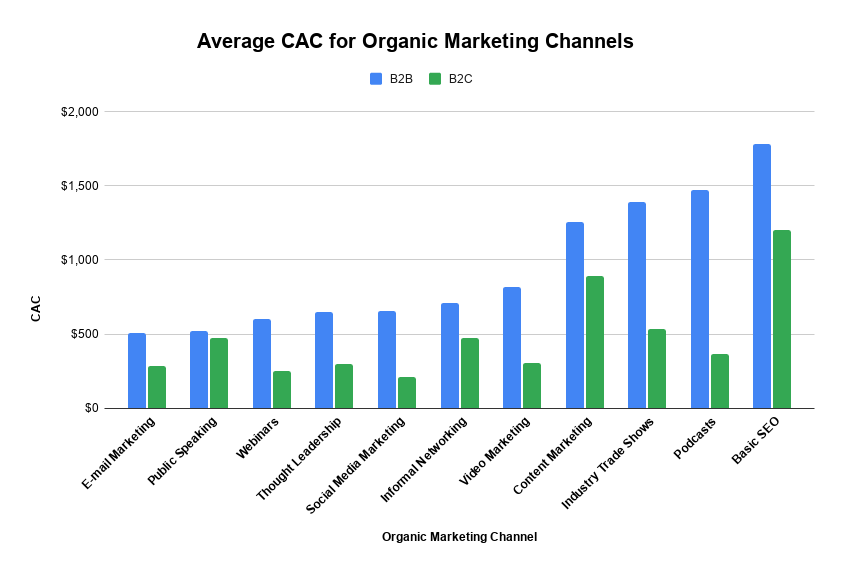
There also seems to be a reason why email, tradeshows, and direct marketing have all seen marketing budget increases in 2023.
All three of these tactics have seen jumps as the top sales/marketing customer acquisition channels, with direct mail and email marketing increasing 10% from where they were in 2022.
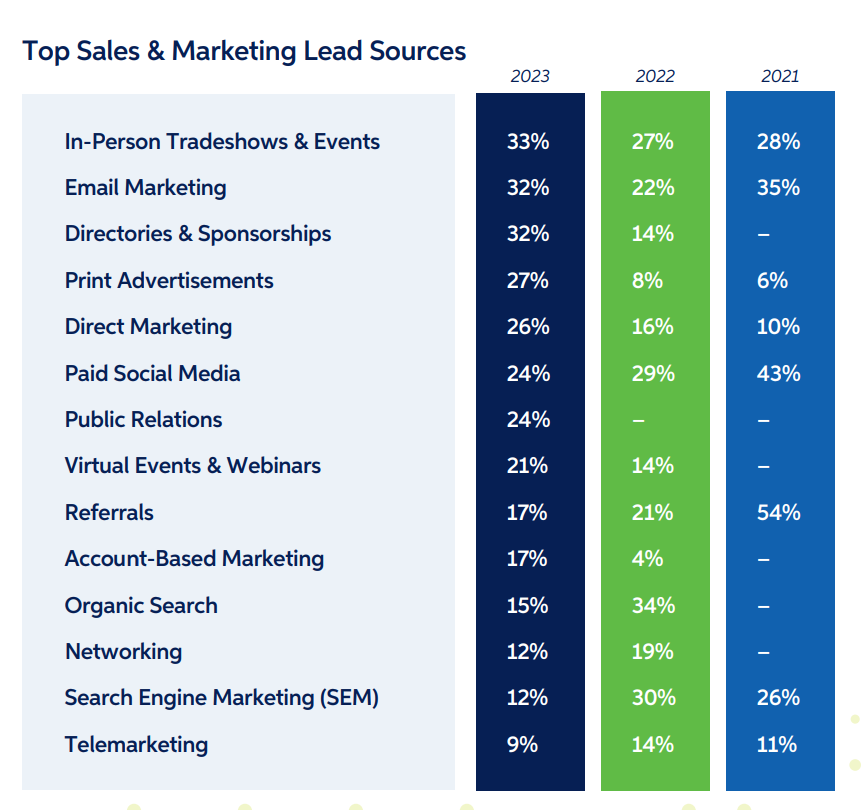
With in-person tradeshows being listed as the number 1 source of sales & leads, marketing and sales teams seem to be slowly transitioning back to more traditional marketing.
Given the success of these channels, we can expect these channels to grow in 2024.
5. Employees Building More Personal Brands and Becoming Brand Advocates
We’ve seen more people than ever creating personal brands and/or creating employee advocacy programs.
Annika Helendi, an SEO consultant at astronaut.marketing, said: “SEO and content will still provide the best ROI on scale but you have to diversify channels and build personal brands which will have more trust as authors. “
Even beyond industry leaders pitching product features, companies are encouraging employees to make social media posts that build awareness for themselves, the brand, and the product.
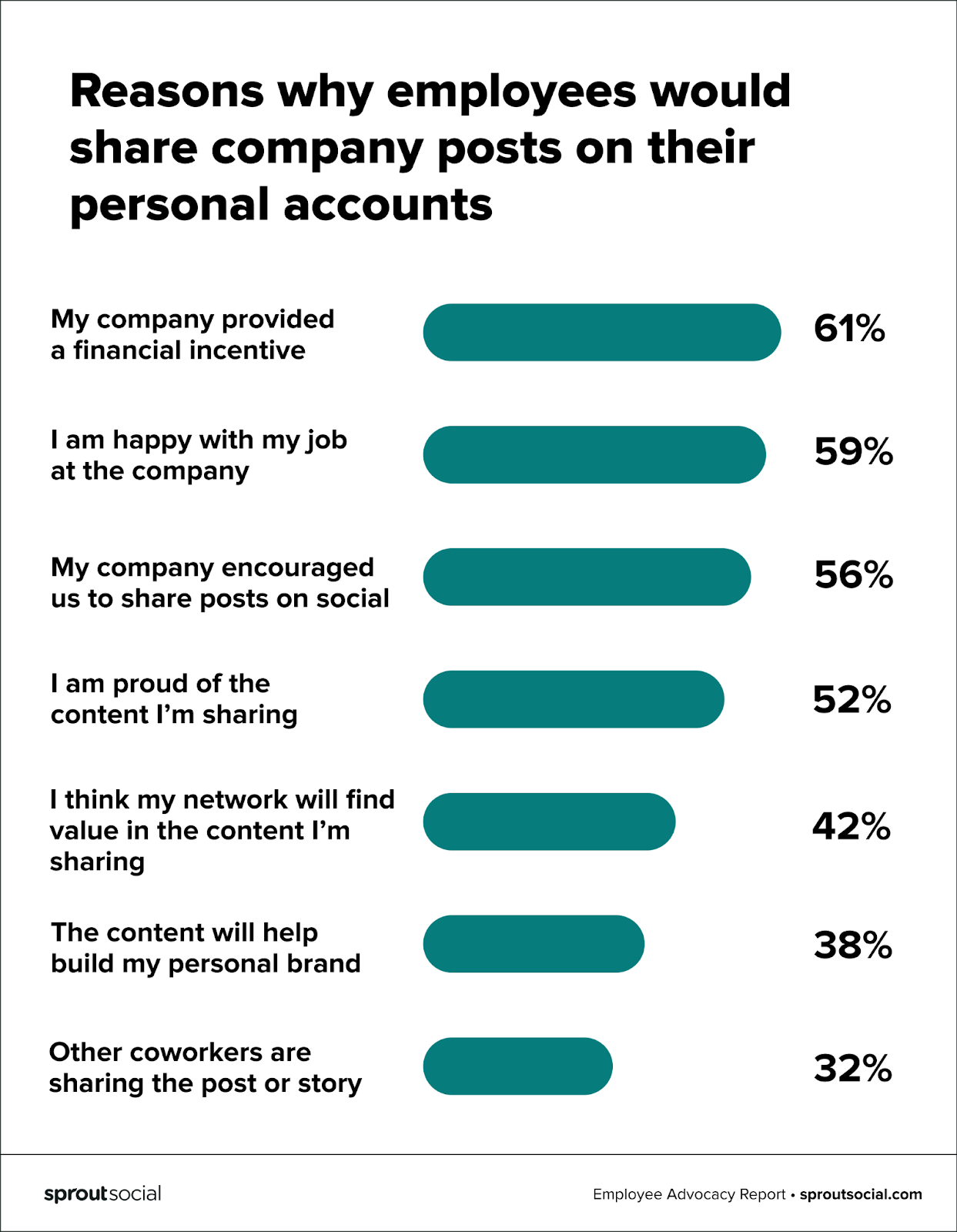
Source: Sprout Social
I personally love this strategy since it allows brands to increase their reach while building the employee a more long-term community.
It’s a win-win in most cases.
But as with industry leaders, your employees have to focus on posting genuinely helpful content and not just pitching your product or brand.
The goal is to build an engaged community.
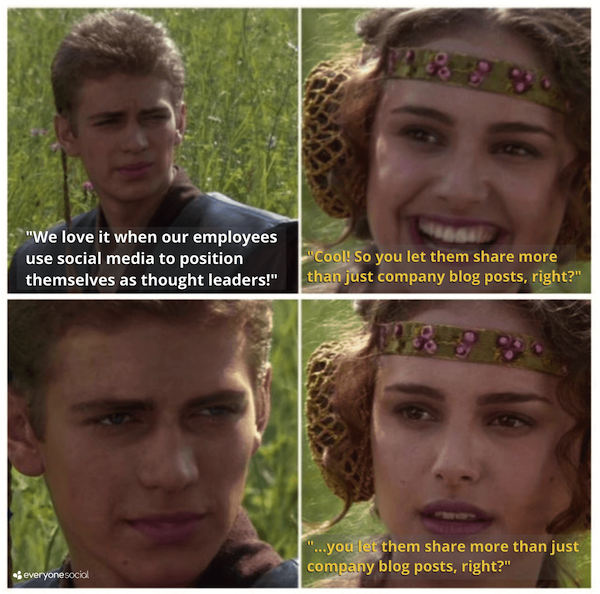
It’s also worth noting that employee content is 8x more likely to receive more engagement than content shared by brand channels.
I’ve seen this personally on LinkedIn too.
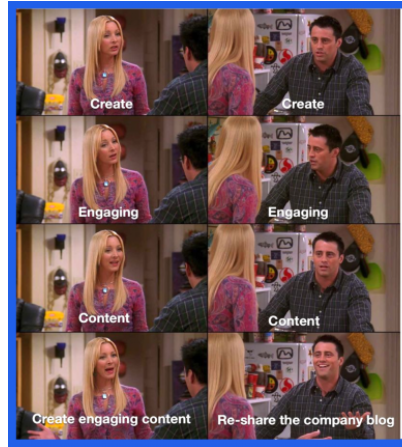
Source: Oktopost
Brand profiles like SEMrush and Ahrefs tend to perform well, but employees (like Patrick Stox) tend to get more engagement (likes, comments, or shares) from each post.
Especially coming from higher-level employees like C-level or marketing directors. It all comes down to the FOMO part: you’re in a place I want to be eventually.
It seems simple enough though; people tend to relate more to actual humans rather than faceless brands.
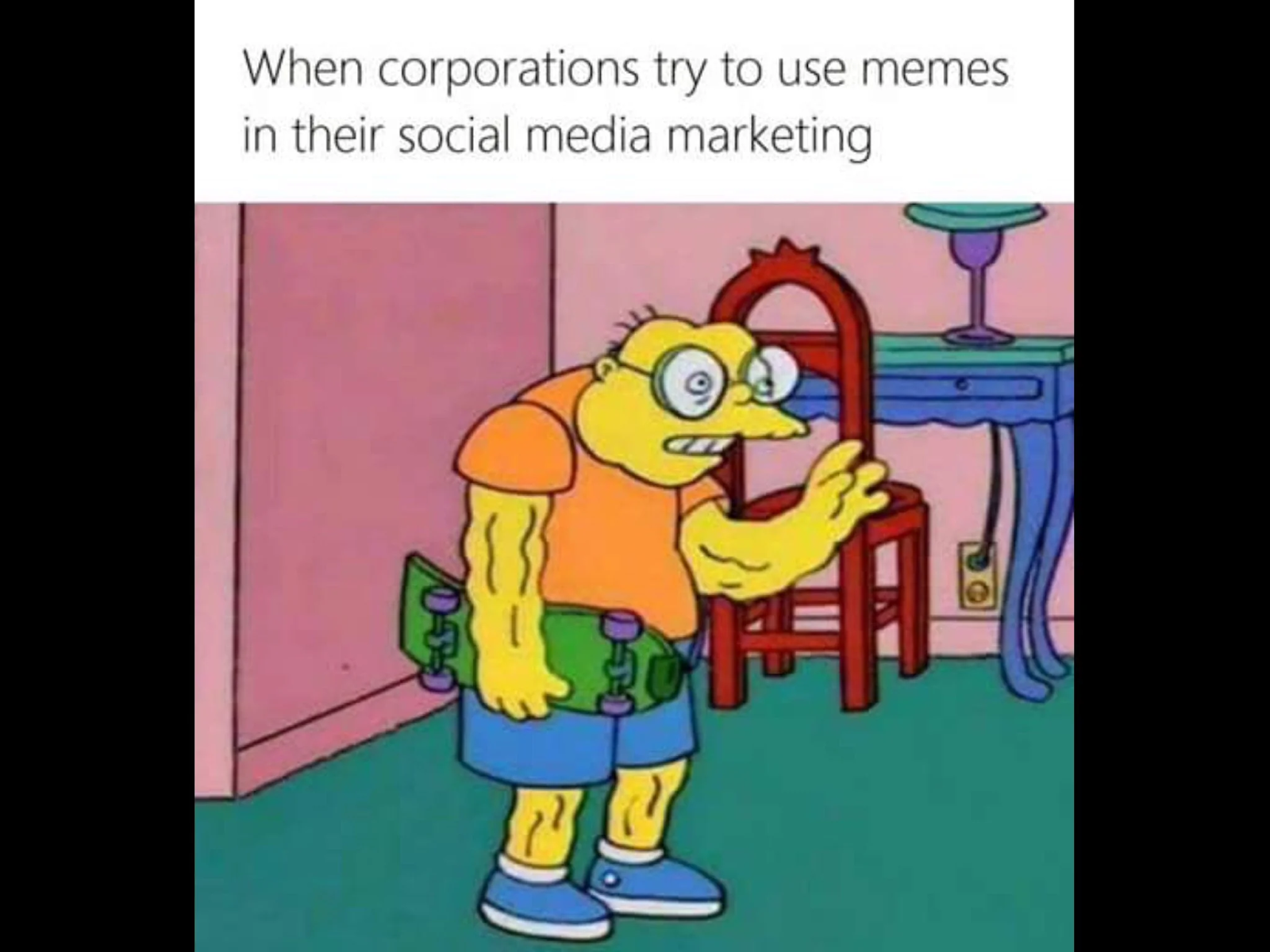
It’s also worth noting that B2B decision-makers use thought leadership to vet a company’s capabilities.
59% agree that an organization’s thought leadership is a more trustworthy source for assessing a company’s capabilities than the company’s own marketing material.
Meaning, they trust what you’re saying (and what others are saying about you), not what you’re pitching.
6. More Content Diversification Beyond Just Blog Articles
What is the first thing that comes to mind when you think of content marketing?
If you’re a content marketer, you’ll probably have several, but most non-marketers think content boils exclusively down to blog content.
And this couldn’t be further from the truth.
This mindset only limits what we could be doing with our marketing efforts.
In most cases, it silos our content and prevents us from pursuing other channels where content can reach the right audiences.
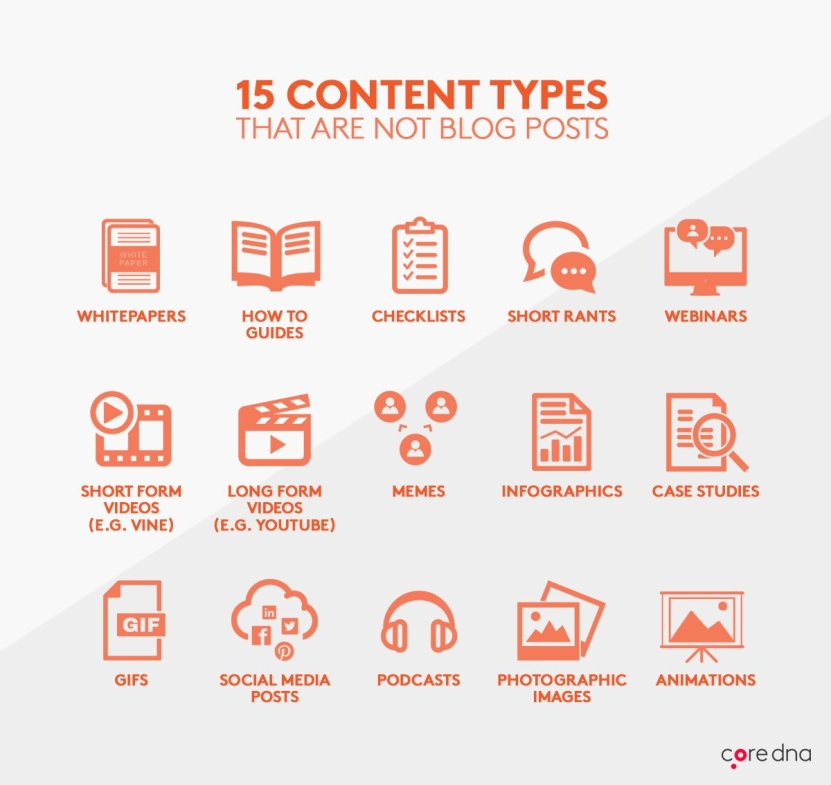
Source: CoreDNA
Antonius Dimitriou, the SEO Lead at Minuttia, had this to say about content diversification: Diversifying content channels and content types. I think blog strategies will be more of a mix of SEO and original / thought leadership content.
And keeping the previous section in mind, most B2B decision-makers trust thought leadership over generic marketing content.
Another important point Antonius mentioned is the diversification of content types. So not just blog content but also videos, images, short-form, and user-generated content.
I’ll talk about this later in the article, but video is poised for a strong takeoff in 2024.
Sorry, spoiler alert.
7. TikTok May Still Be An Untapped Market
With TikTok being one of the most dominant social media platforms out there, some SaaS marketers think it has untapped potential.
Ali Ali, a freelance SEO, had this to say about TikTok marketing: I think TikTok is still super untapped. The average buyer may not be there yet, but it’s a good time to be a first mover.
The key point is the first part he mentioned about the average buyer not being there yet.
When you think of TikTok, you mostly think of entertainment, usually as a way to turn your brain off and relax from work.
Especially when we have platforms like LinkedIn that are more professional-based.
However, if marketers want to include TikTok in their social media strategy, they have to understand what people are looking for.
In 95% of cases, users are on TikTok looking for videos that are digestible and entertaining.
Videos created for consuming, not pitching (you can see there’s a trend here).
This means putting a heavier emphasis on:
- Editing
- Visuals
- Messaging
- Content Type (Entertaining, Promotional, Educational)
- Engagement
While TikTok marketing likely won’t drive direct sales in B2B, it can be a solid channel to grow your community, nurture your audience, and increase brand awareness. It gives you more reach to connect with your audience at different stages of their customer journey.
It’s still to be seen if TikTok marketing can take off, especially for more complex B2B SaaS verticals, but it’s an area to keep your eyes on.
All I know is that I’m mostly on Instagram reels or TikTok for memes, so I’d probably throw my phone if I saw anything business-related.

8. Cold Email Becoming a More Profitable and Effective Marketing Channel
One interesting trend came from Gasparde Pastural, a freelance growth marketer. He said, “Cold emailing is going to become more expensive – but even more efficient and profitable.”
When I asked him to elaborate further, he said: Well cold emails are getting restrained by Gmail, and Yahoo + inbox of C-levels are saturated. Working on delivery + standing out will become the norm, so it’ll distinguish fake experts from real ones, making the real one more expensive, yet with better results as their competitors won’t be able to either land not in spam or they won’t stand out. That’s what I believe, and we kind of see it from those who say “cold email is dead,” meaning they fail, whereas real experts have been thriving since the Gmail announcement.
As previously mentioned, cold email is a noisy channel. So if you want to stand out, you have to be effective with your messaging.
Meaning, you should:
- Avoid generic template emails
- Make your emails personalized experiences
- Make your subject lines stand out
- Be precise with your emails
- Target the right customer personas
- Deliver the right amount of value (not too short but not too long either)
We receive tons and tons of notifications daily (mostly spam), so it’s never been more important to deliver on the value of your emails.
Cold email can be an effective channel, you just have to know how to use it right.
9. Video Marketing Will Continue to Grow as a Main Content Type
The sharp increase in video content is one I’m sure everyone has noticed.
Video content can (and should) be found in almost every content marketing strategy. From YouTube shorts to lengthy courses, Video content is almost impossible to avoid.
It’s not that video marketing will overtake blog content either; we’re now making our content more accessible to different audiences. Visual content and interactive elements that still convey the same marketing message and reach audiences at different touchpoints.
Some people don’t want to read a 3,000-word article when they can watch a 5-10 minute video covering the same information.
Some audiences prefer articles, some prefer videos, and some even prefer shorts that take less than a minute to watch.
This has been the main result caused by the content overload we’ve all experienced.

There’s just so much content to choose from that we have to pick and choose what to digest.
The Content Marketing Institute found that (53%) of B2B marketers find case studies/customer stories and videos to be the most effective content type.
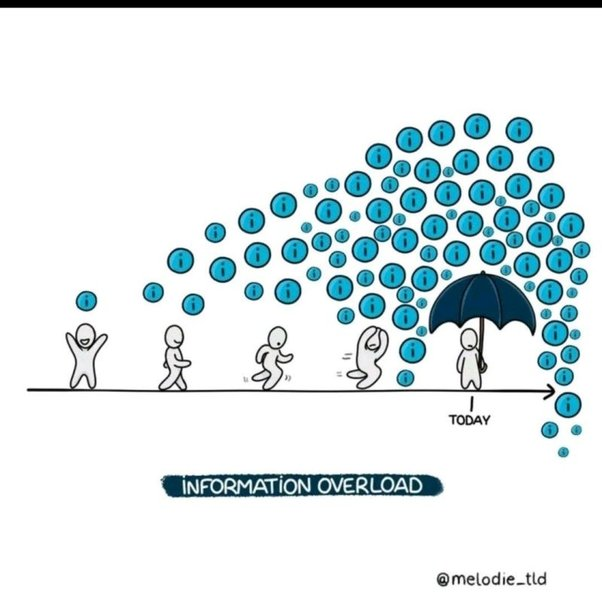
Especially with the short-form content doses of TikTok, YouTube shorts, and Instagram reels, we’re looking to take in only the right kind of content.
There’s a reason why text posts on LinkedIn tend to outperform links to articles.
A post, at most, will take 1-2 minutes to read, whereas most articles will take 15-30 minutes. Articles are typically more of a time commitment than shorts or social posts.
Especially on a social platform with so much noise, it can be overwhelming to sift through all the content that gets posted daily. Here’s something to consider:
- LinkedIn has 2 million posts daily
- TikTok gets 34 million posts daily
- Instagram gets 95 million posts daily
- YouTube gets 3.7 million posts daily
- Websites publish 6 million posts daily
There is just so much noise that we have to cut through here. Not only this, but videos can influence the sales process without your team needing to be involved. A video product demo or company overview can give customers a first-hand look at your solution and company without needing to speak to a sales rep.
Video demos can also be your best friend, as they give users a first glance at your product and how it works.
Lel Barry had this to say about video content: “Video content is another trend I anticipate will record a growing curve. Depending on the platform, short-form videos will continue to do well, offering value in a short time frame.”
He explained another content type he thinks will take off this year. The “muted video.”
He said: A surprising trend that some may not know is “muted video.” I’ve done some testing and found that this type of content format does well. So I won’t be surprised to see it trend in the years to come.
I’ve personally never heard of a “muted video,” so when I asked what that was, he responded with: you create a short video with no sound and write a copy to tag along the video explaining what the content is all about. Should be under a minute.
You’d think it’s crazy based on that description, but it makes sense when about 75% of mobile users watch videos on mute.
So moving into 2024, we can expect a lot more digestible video content to be created for our audiences.
10. B2B SaaS Marketers Will Prioritize Brand Awareness Over Lead Generation
Using Sagefrog’s marketing mix report, marketers believe their tactics will focus more on building brand awareness rather than generating leads and retaining customers.
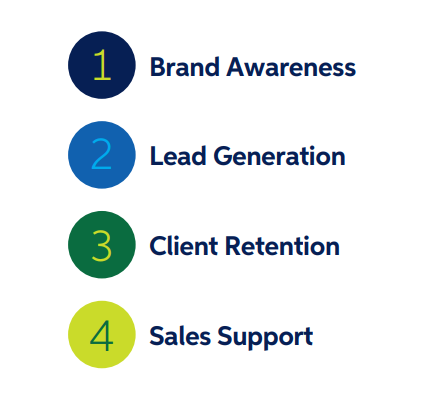
Whether this approach is right or wrong, many B2B marketers find this to be their main priority going into 2024.
However, it is worth noting that a successful marketing strategy should prioritize awareness, lead generation, client retention, and sales support.
Not just one over the other.
Focus on customer retention, building your customer base, and building awareness for your brand.
11. Webinars Will Continue to Be Effective for Brand Awareness and Lead Generation
Continuing off Sagefrog’s marketing mix report, marketers still think highly of webinars for driving business results.
An overwhelming 89% voted “yes” to whether webinars will be effective for brand awareness and lead generation moving into the new year.
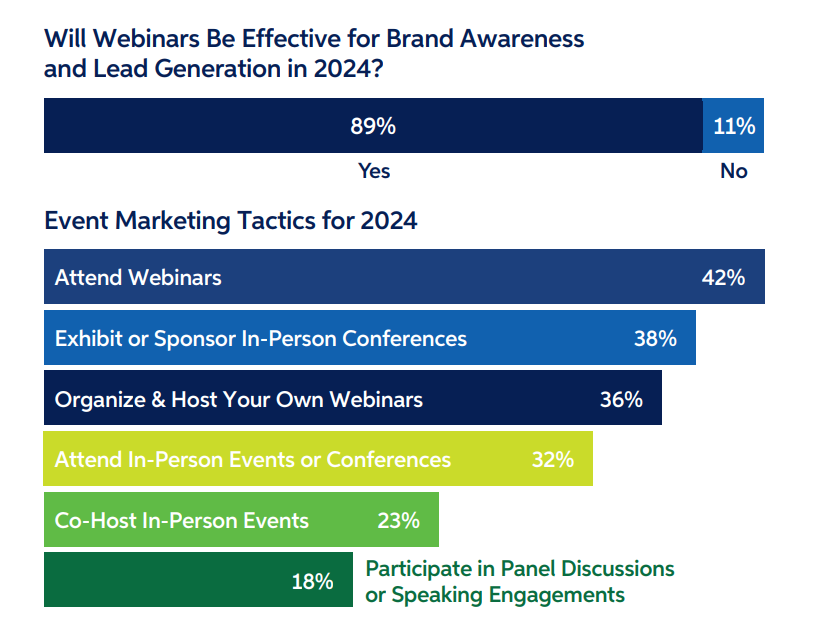
This is a no-brainer too.
Webinars are the perfect opportunity to meet your audience in real-time.
You can either attend an external webinar to meet a new audience, or you can have new audiences come to you by hosting well-known industry leaders.
During your webinar, you can communicate directly with your target audience. You can:
- Ask them personalized questions
- Gauge their interest
- Find their pain point
- Build interest and awareness in your brand/product
Not to mention that webinars can drive direct MQLs as well.
Like your social and influencer content, focus on creating value with your webinar. Don’t use them as an opportunity to pitch your product.
I can’t tell you how often I’ve left webinars early because the whole thing felt like a sales pitch.

Not to mention the sales reps who follow up almost immediately afterwards.
It’s an instant turn-off on the brand and product.
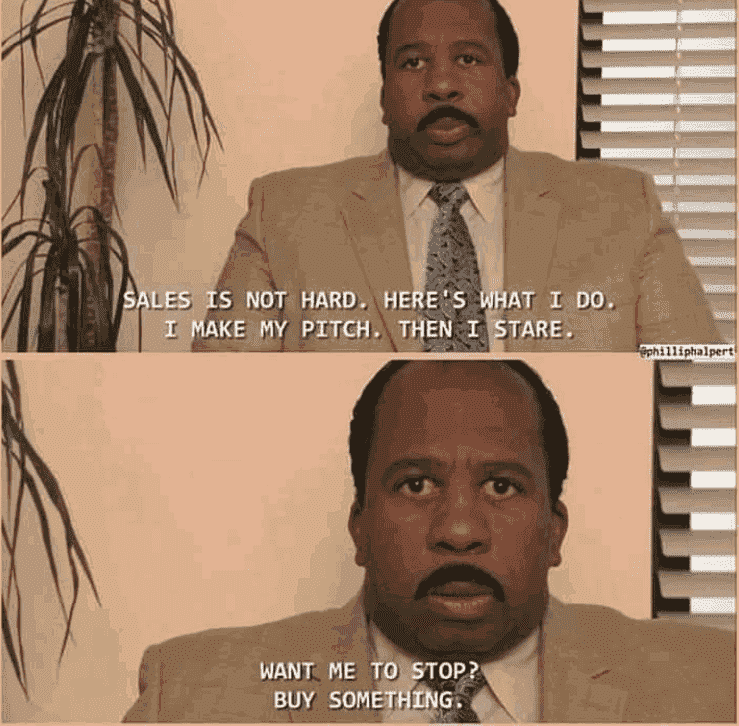
Your audience is taking time out of their day to attend, so really deliver on the value for them. Really focus on making their time worth it.
In all of these cases, whether social, video, webinars, or content, you can see that proper organic growth is done through education, not selling. If you want to grow your community/brand and drive sales, you have to know why your audience is following you in the first place.
Education = trust, and trust = sales.
Keeping all that in mind, it’s safe to say that webinars aren’t going anywhere anytime soon. It will continue to be a solid lead and awareness channel for most B2B growth strategies.
SaaS marketing trends to focus on
So those were the top SaaS marketing trends of 2024. Obviously, a lot of change is happening daily, but none of these changes should be seen as negative. In fact, I’m pretty bullish on marketing (and especially SEO) as a whole. All of these trends will make our efforts more effective and allow us to better resonate with our audiences.
While AI may seem like a “disrupter,” I really think it will be overly abused, causing audiences to seek out brands that actually provide helpful content. All of this will lead to better content, which I’m sure all of us are thrilled about.


.png)


